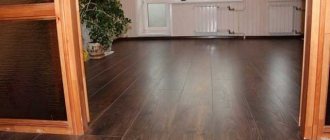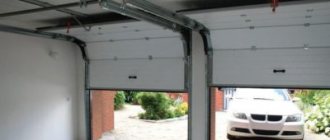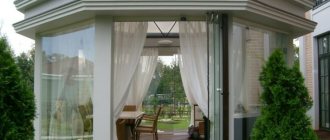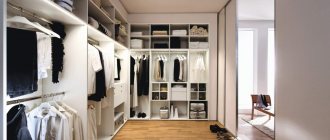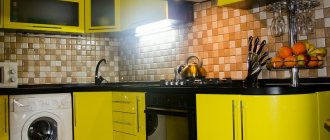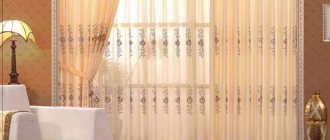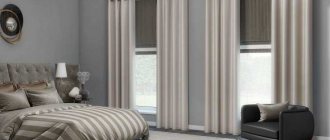For example, on a hot day, the balcony heats up the room adjacent to it, house plants burn under the influence of direct sunlight, and the bright light from lanterns disturbs you at night.
That is why you can see a variety of curtains on almost all modern balconies. Let's figure out which curtains are best suited for placement on balcony windows.
Which blinds are best to hang?
A few recommendations for choosing:
- It is not recommended to choose vertical slats for a small balcony space.
- For a loggia with sliding windows, both vertical and horizontal models with ceiling mounting are suitable.
- For loggias located on the south side, it is advisable to use products made from denser materials.
- It is better to design small balcony windows with horizontal structures, with the type of glass mounting.
- It is better to choose the size of the blinds slats 5-10 cm smaller than the balcony frame.
Types of structures
There are several design varieties of blinds, each of which allows you to choose the ideal solution for decorating your loggia.
Horizontal models
A fairly simple and convenient design does not take up much space, looks weightless and does not overload the space of even the smallest balcony.
Vertical blinds in the interior of a balcony
They are made of plastic, fabric, aluminum, and have many shades and colors. When fully closed, they resemble curtains and perfectly protect the loggia from the sun. It is better to use such models for large areas.
Advantages and disadvantages
To understand which blinds are best to choose for a glazed loggia, compare their types according to the main parameters.
The comparison result can be seen in the table.
| Name of blinds/curtains | Advantages | Flaws |
| Vertical blinds |
|
|
| Horizontal blinds |
|
|
| Pleated |
|
|
| Multi-textured |
|
|
| Roller blinds |
|
|
| Roller shutters of different types |
|
|
What lamella material is suitable for a balcony?
For the manufacture of lamellas, various types of materials with very different textures and densities are used.
Fabric
Lightweight, resistant to sunlight and not subject to deformation. The only disadvantage of fabric models is their rapid contamination.
Plastic
Plastic blinds for the balcony are easy to maintain, practically do not fade in the sun and do not lose their appearance over time. However, slats made of inexpensive plastic deteriorate very quickly due to the fact that they are exposed to mechanical stress.
Aluminum
Strong and durable metal slats are easy to clean and are not afraid of moisture. A small drawback is that such structures create noise when opening and closing the doors.
Wooden
They look very beautiful and expensive. The lamellas do not fade in the sun and do not dry out. Natural bamboo products look original and exotic and instantly attract attention.
Paper
Pleated paper blinds are a universal and multifunctional option for decorating balcony windows. Indoors, they create a unique comfort.
What curtains to decorate the loggia with?
The choice of curtains is based on decorativeness and often the ability to fasten curtains without a cornice - this is a feature of balcony rooms. Models that meet these requirements are grouped into 3 groups: classic, lifting, sliding.
All curtains made from ordinary fabrics are susceptible to contamination and fading, and removing them from the balcony can sometimes be problematic.
Classic
This includes the well-known fabric curtains. Both dense and lightweight materials are selected for the balcony. If you only need to cover the glass, then transparent or translucent fabrics are suitable. A thick curtain will help you securely close yourself off from prying eyes or noise. Typically, classic curtains require curtain rods, but you can also hang curtains without a cornice with your own hands.
Related article: Using liquid wallpaper to decorate a children's room
Lifting systems
Many designs fall into this category and each of them can be used for a balcony:
- Roman - rising up canvases with horizontally folded fabric. They are functional, beautiful, and made from various materials. There are several ways to attach curtains without a cornice to balcony windows. The Austrian, English, French models are similar to them, differing from each other in the splendor of the folds
Roman curtain
- Vietnamese - a rectangular piece of fabric is rolled into a roll and secured at the desired height with tapes. These are double sided curtains.
If you need the installed curtains on the balcony to constantly fall and rise, then using Vietnamese curtains will be inconvenient.
- Rolled - in them the fabric is wound onto a shaft using a chain mechanism. These are the most functional curtains to cover a balcony. Reliable and convenient control mechanisms, fabrics impregnated with dust- and water-repellent compounds that do not fade from the sun are the main differences between these systems and curtains made from conventional materials. The abundance of colors, textures and simple installation make roller blinds on the loggia a true favorite. Large structures are equipped with an electric motor.
Sliding systems
To create a minimalist interior, you can install Japanese curtains on the balcony. The top rail is attached to the ceiling, which usually does not cause problems. Lower - to the window sill or floor - loggias in modern apartments are completely glass.
Tips for choosing
So, when choosing blinds for a balcony, consider the following:
- Classic horizontal blinds, which are attached directly to the doors, cannot be installed on sliding aluminum frames. You need to select models mounted on walls or ceilings. Aluminum sliding sashes require blinds that are attached to the wall or ceiling.
- For lovers of sophisticated design, I would recommend pleated blinds. They look especially organic on large windows, which are typical for balconies.
- Buy roller blinds that are mounted on rails. Then, when opening the doors for ventilation, the curtains will not hang and dangle. You can generally purchase cassette curtains, in which the roll is disguised in a special cassette.
What types of loggia blinds are there?
Blinds for plastic windows on the balcony allow you not only to provide control over the level of light, but also to stylishly decorate the room.
- Pleated. They are a design with pleated fabric in the form of an accordion with folds of two centimeters.
- Classic. Plain vertical and horizontal sun protection slats will be the most optimal solution for creating a modern and practical look for your loggia.
- Photo blinds are the most beautiful look with bright and clear images printed using photo printing. You can choose the print format yourself; this is an undeniable advantage for creative people. They will add a special mood to the balcony room.
- Multi-texture blinds are a universal type that combines the advantages of fabric and plastic slats.
How to install curtains if there is no cornice
There are different ways to hang curtains on the balcony without a cornice. The choice depends on the type of curtain.
Classic
To hang curtains without curtains, that is, in one row, you can use the following tricks:
- Stretch a metal string across the entire width of the loggia - this method is suitable for light fabrics;
- Stretch the fishing line - if there is no string or you need to attach the fabric to each sash. For this you will need beautiful carnations. Sometimes a line is passed along the bottom edge of the fabric to secure it;
- You can hang curtains without a cornice by installing hooks and sewing loops to the curtains. For plastic doors, hooks with Velcro are selected;
- Attach suction cups to the glass, and then hang light curtains on them.
Related article: How to fix a sink?
Roman curtains
To hang curtains, in addition to the cornice, a wooden block and Velcro adhesive tape are used. Installation is carried out to each sash or across the entire width of the balcony.
The hard part of the Velcro is attached to a block that fits in size. It is glued, stapled, and nailed. The timber is secured with self-tapping screws to the selected surface of the opening. The soft part of the tape is sewn to the fabric. In extreme cases, the fabric is connected to the bar with staples or nails, but this method is extremely non-functional - it will be extremely difficult to remove it.
You can attach rag blinds to the balcony - Roman blinds - to each sash separately. To do this, Velcro tape is again used with an adhesive backing on the hard part.
How to choose for windows of different shapes?
Blinds on the balcony allow the windows to take on a more thoughtful, deep and stylish look. However, windows can be not only standard, but also of various shapes and designs. Let's consider special cases in more detail.
Blinds on sliding windows on the balcony
Both horizontal and vertical models with a ceiling profile are suitable for sliding windows.
Panoramic windows
For such window openings, you can choose vertical slats to the floor, which can reach up to 6 meters in length or more. Panoramic windows on a small French balcony are decorated with horizontal slats and pleated blinds. They look light and make the room more spacious.
Photo of a loggia 6 meters
Sources
- https://kvadratnyjmetr.ru/lodzhiya-6-metrov/
- https://salon.ru/article/luchshie-idei-dizajna-dlya-lodzhii-ploshchadyu-6-kvadratnyh-metrov-51772
- https://tytdesign.info/lodzhiya-6-metrov/
- https://www.ivd.ru/stroitelstvo-i-remont/balkony-i-lodzii/dizajn-lodzhii-ploshchadyu-6-kvadratnyh-metrov-50-foto-49951
- https://manrule.ru/lodzhiya-i-balkon/dizajn-6-metrov/
- https://okna-dom.net/dizayn-lodzhii-6-metrov/
- https://megadizajn.ru/lodzhiya-6-metrov/
Mounting methods
All blinds, differing in type, are fixed to surfaces in several ways:
- Drilling holes in the wall. This is possible if the installation is performed on a separate window unit. This method is not suitable for sliding systems, as well as for a loggia 6 meters long. Moreover, the structure should overlap the windows by 10 cm on each side.
- Installation of cornice on the ceiling. In this case, the blinds will serve as curtains. They completely block the view of the room from the street (an important feature for apartments on the ground floors), as they hang from the ceiling.
- Installation on a window frame. This option is suitable for horizontal blinds, roller blinds, and pleated blinds. The cornice is fixed above the double-glazed window, and a restrictive beam is attached below. For a compact loggia this is the most suitable method.
- Fixation without fasteners - using double-sided tape. This method is not very reliable, but it allows you to install the blinds yourself. Moreover, it is suitable for windows of any type. The structure is attached to the frame.
Which color should I choose?
Various shades create a sophisticated color scheme in the room.
Multicolored
Quite an interesting solution that allows you to enliven and add variety to a laconic and austere balcony space.
Blue
The blue color evokes associations with the sea and gives a feeling of coolness. Therefore, blue or light blue slats are especially suitable for loggias located on the sunny south side.
White
White models reflect light well and return it to the room, thereby creating a visual enlargement of the small balcony space.
Beige
Classic design option. Calm and gentle beige on plastic windows does not have an irritating effect and looks very organic.
Reds
They attract attention and look quite stylish. But on a small balcony, dark red slats will make the space overloaded.
Loggia size and choice of curtains
A balcony curtain should create a harmonious image of the room, sometimes change its geometry, and be as functional as possible. These qualities are determined by the dimensions of the loggia.
Related article: Replacing a window sill with your own hands
For a small balcony
Curtains are chosen from light fabrics, because dark ones will make the area even smaller. For the same reason, it is not recommended to hang curtains to the floor, use fabrics with lush drapery, for example, French, and overuse accessories. It is better to hang curtains on each window separately and choose plain fabrics. Let's say a small drawing.
Roll systems, Roman, Austrian and classical, are suitable for a small balcony.
For a large loggia
A fully glazed loggia looks great with classic floor-length curtains and tiebacks. Several canvases with separate string cornices will allow you to flexibly adjust the lighting. Here you can hang any curtains - Roman, Japanese, French, Vietnamese, or install a roller mechanism. It is better to cover each sash with a separate leaf - large ones are difficult to control and regulate the light output.
WATCH VIDEO INSTRUCTIONS
For any balcony windows you can find and hang curtains to your liking. You especially need to take a closer look at roll models.
They are easy to care for, the wealth of choice allows you to choose blinds to suit any style, and installing them is easy and simple. Fastenings without drilling will not harm the plastic window.
What to install on the balcony: blinds or roller blinds?
Recently, installed blinds or roller blinds can increasingly be seen on balconies and loggias. And in fact, there is a reasonable explanation for this.
Balcony glazing typically takes up a larger area (compared to simple room windows) and the problem of light control, privacy and sun protection for such large windows is actually more pressing.
Blinds or roller blinds installed on the balcony solve these problems. They are easy to use, practical, and many of their systems are designed specifically for plastic windows.
Therefore, very often our customers have a question: what to install on the balcony – blinds or roller blinds? In fact, many sun protection systems are installed on the balcony.
And often the decision to install a particular design of blinds or roller blinds is made taking into account several factors:
- prices, convenience and individual requirements for the ordered products (sunny side or shady side near the balcony;
- color scheme of the balcony and interior;
- regular plastic windows on the balcony or sliding ones, etc.).
Vertical blinds installed on a balcony or loggia
Vertical blinds on balconies or loggias are usually installed on the ceiling. Depending on the necessary requirements for the product, as well as on the length of the balcony or loggia, this type of blinds is usually manufactured in one or two products.
For balconies and loggias, vertical blinds will in most cases be the most inexpensive option for sun protection products.
The advantages of vertical blinds installed on the balcony:
- Vertical blinds for the balcony are made of fabrics with dust-repellent impregnation. This means that maintenance of these products will be minimal.
- Vertical blinds allow you not only to block out the sun, but also to control the illumination of the balcony by turning the slats in the direction you need.
- Vertical blinds are suitable for any type of balconies - with tilt-and-turn windows and with sliding windows.
- Vertical blinds can be made with different control methods: the slats can move in one direction (for example, towards the mechanism) or in different directions from the center. Also, vertical blinds can be made on several cornices, and the products will be installed close to each other. This will also allow you to tailor product control to the characteristics of your balcony.
- Vertical blinds have a large number of variations and can fit into any interior. Their slats can be made of a variety of fabrics, both the simplest and the most exclusive; they can alternate in a special way. They can be made of several materials (these will already be multi-textured vertical blinds) or photo printing with different views, pictures or textures can be applied to the slats.
Tips for installing vertical blinds on a balcony.
- As a rule, vertical blinds for balconies are installed on the ceiling, so their installation in this sense must be technically possible. Windows on the balcony must be made in such a way that the cornice of vertical blinds installed on the ceiling allows them to open.
- Since vertical blinds will inherently be installed in front of the window, when installing them on a balcony, it is necessary to ensure that the balcony windows open and are accessible. That is, the method of controlling the blind product must be chosen correctly.
Horizontal classic blinds on balconies and loggias
Horizontal classic blinds for balconies are usually installed on each window sash. Therefore, the windows on the balcony to select this sun protection system must be tilt-and-turn (not sliding).
Horizontal classic blinds for balconies are also one of the most inexpensive options for blinds, so they are very common. Since horizontal classic blinds are installed on each sash of a plastic window, the control of lighting on the balcony will be more functional; each sash will be controlled separately.
The advantages of horizontal classic blinds installed on the balcony:
- Horizontal classic blinds are installed on each sash of a plastic window, which means that the illumination of each sash will be adjusted separately.
- Horizontal classic blinds allow you not only to block out the light, but also to control it by turning the slats. This may be especially true if you have flowers on your balcony. By directing the slats of the blinds upward, the sun will not fall on the flowers, while the room will be light.
- Horizontal classic blinds have a different number of variations. You can order them in different colors, with different lamella widths (16 or 25mm), combine lamellas from several colors, or order photo printing on them.
Details
Varieties + review
Various design options make it possible to adapt blinds to specific operating conditions. For example, if you have sliding windows, you can use ceiling fasteners. On a south-facing balcony, you can use blinds with a light reflection effect, which make it possible to maintain a comfortable temperature level from the inside. Roller blinds for balconies are ideal for loggias that are connected to living rooms. According to the types of design, blinds can be classified into the following types:
- Vertical - the lamellas in them are placed exclusively parallel to each other, that is, from top to bottom, and when assembled they are moved to the side. They are mounted on a plastic or aluminum cornice, and can be controlled via a cord. The design also includes a set of weights, runners and a chain to connect all the elements. Mounting is done on walls or ceilings, brackets, blinds are made from various materials, they can have a textured surface.
- Horizontal - they can be installed directly on the window frame, tightly to the glass surface, with slats that are placed parallel to each other. In such a system, transformation mechanisms like an “accordion” are used, and the fastening is made on the slope of the opening, frame or wall surface. As a rule, blinds are installed individually for all sashes, which makes it possible to supplement the glazing with a window sill without interfering with opening.
- Rolled - these types of window structures for protection from light are also called rolled. They are rolled up inside a special box, on a shaft, installed on wall/ceiling surfaces, and also on the window frame itself. They even produce solid models or a “day-night” variety with a colorless insert on both canvases that move relative to each other. This option is very convenient for installation both on windows inside the balcony and on frame glazing.
- Pleated blinds - these blinds look similar to roller blinds, but at the same time have a corrugated structure. There are models for tilt-and-turn windows, attic structures and other types of glazing. They are mounted on brackets or between the eaves, on guide cords, and opening is done by pulling a chain/cord; you can install an electric drive.
- Threaded ones - they are used on a balcony with panoramic glazing, they are fixed only from above, and they also have a vertical arrangement. Instead of simple lamellas, multi-colored threads with weights are used here, which are shifted to the side or around the axis. When closed, they look like a weightless curtain that sways when the breeze blows.
All designs have their own properties, and their choice is often determined by the type of sashes or glazing used for the balcony. Vertical types of blinds are ideally combined with sliding sashes and an opening system. For swing structures, horizontal blinds for the balcony would be an ideal option.
Color solutions
Modern curtains and blinds for balconies are available in a wide variety of designs and colors. Each type has certain characteristics, for example, models of pleated blinds are usually made in pastel colors - from snow-white to light beige, pale pink, blue. Roller blinds are made in plain colors or even with thematic patterns (abstract and geometric patterns, floral patterns). Color variations for blind systems can be divided into different groups:
- Neutral – this includes universal solutions that are suitable for any type of balcony design. Usually milky, light beige, gray or cream tones are used.
- Contrasting - they create dissonance with the frame design or other details of the balcony decoration. here you can focus on golden or even silvery bright options, light green, orange, and deep pink shades.
- To match the frame - in this case, the blind system is chosen according to the design of the main glazing, and usually a brown or white shade is chosen, as well as products with imitation wood texture or metallic colors.
- To match the color of the finish, blinds are chosen based on the general style direction of the balcony. For example, white and blue tones are ideal for a Mediterranean aesthetic, while a dramatic combination of black and red is ideal to emphasize art deco. The laconicism of the modern style direction can be complemented by the graphite and milky “domino” range.
- With 3D print - this design of blinds makes it possible to create single- or double-sided canvases in a closed form, three-dimensional ornaments and patterns, and transfer reproductions of paintings or photos to the surface of the blinds.
If the outside of the balcony is decorated with siding, then you can choose blinds to match the panels. This combination will look appropriate, aesthetically pleasing and neutral.
Materials
Depending on the material used for the base, blinds can be textile and wood, plastic and metal. Each of these options has certain advantages and disadvantages. In any case, the material must be durable, lightweight, and also resistant to ultraviolet rays. Only a few types meet these requirements:
- Plastic is the most popular option, which is lightweight, high elasticity and strength. Polymer blinds can withstand long-term contact with direct sunlight, are easy to clean, and are also suitable for installation on different types of glazing. Their huge advantage is the variety of shades and colors.
- Fabric - they are created using lightweight and easy-to-care polyester, which is resistant to the effects of the sun's rays. They have a long service life and are also produced in a wide range of colors. Textile blinds can decorate a French-style loggia/balcony.
- Wooden - natural pine, bamboo blinds are also made with the thinnest slats, which are treated with a protective varnish that protects them from atmospheric influences. To limit the length, they use a special handle, and such blinds look ideal on balconies in country houses, they have bright colors or natural shades.
- Metal - they are created using lightweight aluminum, which retains its natural shade or is painted. This option is durable and can withstand heavy operating loads. An ideal addition to modern-style balcony decoration.
- Paper - it is from this material that pleated curtains are made. They are not entirely practical, they are only suitable for use inside the balcony, behind the glazing, and do not yet provide complete privacy, and when darkness falls, this fence will turn the space into a real shadow theater.
In many ways, the choice of materials is interconnected with the type of blinds design. For example, roll versions are usually made of fabric, horizontal ones are made of plastic.
Color solutions
Modern curtains and blinds for balconies are available in a wide variety of designs and colors. Each type has certain characteristics, for example, models of pleated blinds are usually made in pastel colors - from snow-white to light beige, pale pink, blue. Roller blinds are made in plain colors or even with thematic patterns (abstract and geometric patterns, floral patterns).
Color variations for blind systems can be divided into different groups:
- Neutral – this includes universal solutions that are suitable for any type of balcony design. Usually milky, light beige, gray or cream tones are used.
- Contrasting - they create dissonance with the frame design or other details of the balcony decoration. here you can focus on golden or even silvery bright options, light green, orange, and deep pink shades.
- To match the frame - in this case, the blind system is chosen according to the design of the main glazing, and usually a brown or white shade is chosen, as well as products with imitation wood texture or metallic colors.
- To match the color of the finish, blinds are chosen based on the general style direction of the balcony. For example, white and blue tones are ideal for a Mediterranean aesthetic, while a dramatic combination of black and red is ideal to emphasize art deco. The laconicism of the modern style direction can be complemented by the graphite and milky “domino” range.
- With 3D print - this design of blinds makes it possible to create single- or double-sided canvases in a closed form, three-dimensional ornaments and patterns, and transfer reproductions of paintings or photos to the surface of the blinds.
If the outside of the balcony is decorated with siding, then you can choose blinds to match the panels. This combination will look appropriate, aesthetically pleasing and neutral.
